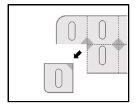
ТАПИМИО 100 мг ТАБЛЕТКИ ПРОЛОНГИРОВАННОГО ДЕЙСТВИЯ
Спросите врача о рецепте на ТАПИМИО 100 мг ТАБЛЕТКИ ПРОЛОНГИРОВАННОГО ДЕЙСТВИЯ

Инструкция по применению ТАПИМИО 100 мг ТАБЛЕТКИ ПРОЛОНГИРОВАННОГО ДЕЙСТВИЯ
Введение
Инструкция: информация для пациента
Тапимио 100 мг пролонгированные таблетки EFG
Тапентадол
Внимательно прочитайте всю инструкцию перед началом приема этого препарата, поскольку она содержит важную информацию для вас.
- Сохраните эту инструкцию, поскольку вам может потребоваться прочитать ее снова.
- Если у вас есть какие-либо вопросы, проконсультируйтесь с вашим врачом или фармацевтом.
- Этот препарат назначен только вам, и не передавайте его другим людям, даже если у них такие же симптомы, как у вас, поскольку это может нанести им вред.
- Если вы испытываете побочные эффекты, проконсультируйтесь с вашим врачом или фармацевтом, даже если это побочные эффекты, которые не указаны в этой инструкции. См. раздел 4.
Содержание инструкции
- Что такое Тапимио и для чего он используется
- Что вам нужно знать перед началом приема Тапимио
- Как принимать Тапимио
- Возможные побочные эффекты
- Хранение Тапимио
- Содержание упаковки и дополнительная информация
1. Что такое Тапимио и для чего он используется
Тапентадол - активное вещество Тапимио - является сильным обезболивающим средством, принадлежащим к классу опиоидов.
Тапимио используется для лечения сильной хронической боли у взрослых, которую можно эффективно лечить только с помощью опиоидного обезболивающего.
2. Что вам нужно знать перед началом приема Тапимио
Не принимайте Тапимио:
- если вы аллергичны к тапентадолу или любому другому компоненту этого препарата (указанному в разделе 6),
- если у вас астма или если ваша дыхание замедлено или слишком мало до опасных уровней (депрессия дыхания, гиперкапния),
- если у вас паралич кишечника,
- если вы употребляли алкоголь, снотворные таблетки, другие обезболивающие или другие психотропные препараты (препараты, влияющие на настроение и эмоции) в высоких дозах (см. раздел "Другие препараты и Тапимио").
Предостережения и меры предосторожности
Проконсультируйтесь с вашим врачом или фармацевтом перед началом приема этого препарата:
- если ваше дыхание замедлено или слишком мало,
- если у вас повышенное внутричерепное давление или нарушение сознания до комы,
- если у вас была черепно-мозговая травма или опухоли мозга,
- если у вас есть заболевание печени или почек (см. раздел "Как принимать Тапимио"),
- если у вас есть заболевание поджелудочной железы или желчных путей, включая панкреатит,
- если вы принимаете препараты, называемые смешанными агонистами/антагонистами опиоидных рецепторов μ (например, пентазоцин, налбуфин) или частичными агонистами опиоидных рецепторов μ (например, бупренорфин),
- если вы склонны к эпилепсии или судорогам, или если вы принимаете другие препараты с известным риском увеличения судорог, поскольку риск этих приступов может увеличиться.
- если вы или член вашей семьи имеет историю злоупотребления алкоголем, рецептурными препаратами или незаконными веществами ("аддикция").
- если вы курите,
- если у вас когда-либо были проблемы с настроением (депрессия, тревога или расстройство личности) или если вы получали лечение от психиатра за другие психические заболевания.
Этот препарат содержит тапентадол, который является опиоидным препаратом. Повторное использование опиоидных обезболивающих может привести к привыканию к препарату (может привыкнуть к нему). Также может привести к зависимости и злоупотреблению, что может привести к потенциально смертельной передозировке. Важно сообщить вашему врачу, если вы думаете, что можете развить зависимость от этого препарата. Его использование (даже в терапевтических дозах) может вызвать физическую зависимость, что может привести к симптомам отмены и повторению ваших проблем, если вы внезапно прекратите принимать этот фармацевтический препарат.
Тапентадол может вызывать физическую и психологическую зависимость. Если у вас есть склонность к злоупотреблению препаратами или зависимость от препаратов, вы должны принимать эти таблетки только в течение короткого периода времени под строгим медицинским наблюдением.
Расстройства дыхания, связанные со сном
Тапентадол может вызывать расстройства дыхания, связанные со сном, такие как апноэ во сне (затруднение дыхания во сне) и гипоксемия, связанная со сном (низкие уровни кислорода в крови). Симптомы могут включать паузы в дыхании во сне, ночные пробуждения из-за затруднения дыхания, трудности с поддержанием сна или чрезмерную сонливость днем. Если вы или другой человек наблюдает эти симптомы, проконсультируйтесь с вашим врачом. Ваш врач может рассмотреть возможность снижения дозы.
Другие препараты и Тапимио
Сообщите вашему врачу или фармацевту, если вы принимаете, недавно принимали или можете принять любой другой препарат.
- Риск побочных эффектов увеличивается, если вы принимаете препараты, которые могут вызывать судороги (приступы), такие как определенные антидепрессанты или антипсихотики. Риск судорог увеличивается, если вы принимаете этот препарат одновременно с этими препаратами. Ваш врач скажет вам, подходит ли этот препарат для вас.
- Совместное использование тапентадола и седативных препаратов, таких как бензодиазепины или связанные с ними препараты (определенные снотворные таблетки или транквилизаторы [например, барбитураты] или обезболивающие, такие как опиоиды, морфин и кодеин [также как препарат для кашля], антипсихотики, антигистаминные препараты H1, алкоголь), увеличивает риск сонливости, дыхательных затруднений (депрессия дыхания), комы и может быть потенциально смертельным. Из-за этого совместное использование должно учитываться только тогда, когда нет других вариантов лечения.
Однако, если ваш врач назначает тапентадол с седативными препаратами, он должен ограничить дозу и продолжительность совместного лечения.
Совместное использование опиоидов и препаратов, используемых для лечения эпилепсии, невропатической боли или тревоги (габапентин и прегабалин), увеличивает риск передозировки опиоидов, депрессии дыхания и может быть потенциально смертельным.
Сообщите вашему врачу, если вы принимаете габапентин или прегабалин или любой другой седативный препарат, и следуйте точно рекомендованной дозе вашего врача.
Было бы полезно сообщить друзьям или членам семьи, чтобы они были осведомлены о вышеуказанных симптомах и знаках. Свяжитесь с вашим врачом, когда испытываете эти симптомы.
- Если вы принимаете препарат, который влияет на уровень серотонина (например, определенные препараты для лечения депрессии), проконсультируйтесь с вашим врачом перед приемом этого препарата, поскольку были случаи "серотонинового синдрома". Серотониновый синдром является редким, но потенциально смертельным заболеванием. Симптомы могут включать непроизвольные сокращения мышц, включая мышцы, контролирующие движение глаз, агитацию, чрезмерное потоотделение, дрожь, усиленные рефлексы, увеличение мышечного тонуса и температуру тела выше 38°C. Ваш врач может предоставить дополнительную информацию.
- Не было изучено совместное использование тапентадола с другими типами препаратов, называемых смешанными агонистами/антагонистами опиоидных рецепторов μ (например, пентазоцин, налбуфин) или частичными агонистами опиоидных рецепторов μ (например, бупренорфин). Возможно, что тапентадол не будет иметь одинаковую эффективность, если его принимать вместе с одним из этих препаратов. Сообщите вашему врачу, если вы сейчас проходите лечение одним из этих препаратов.
- Прием этого препарата вместе с сильными ингибиторами или индукторами (например, рифампицин, фенобарбитал, трава Святого Иоанна) определенных ферментов, необходимых для удаления тапентадола из вашего организма, может повлиять на эффективность тапентадола или вызвать побочные эффекты, особенно когда начинается или прекращается это другое лечение. Сообщите вашему врачу о всех препаратах, которые вы принимаете.
- Тапентадол не должен приниматься вместе с ингибиторами МАО (препараты для лечения депрессии). Сообщите вашему врачу, если вы принимаете ингибиторы МАО или если вы принимали их в течение последних 14 дней.
Прием Тапимио с пищей, напитками и алкоголем
Не употребляйте алкоголь во время приема этого препарата, поскольку некоторые из его побочных эффектов, такие как сонливость, могут увеличиться. Прием пищи не влияет на действие этого препарата.
Беременность и лактация
Если вы беременны или в период лактации, считаете, что можете быть беременной или планируете стать беременной, проконсультируйтесь с вашим врачом или фармацевтом перед использованием этого препарата.
Не принимайте этот препарат:
- если вы беременны, если только ваш врач не назначил его вам, если используется в течение длительного периода во время беременности, тапентадол может вызвать симптомы отмены у новорожденного, что может поставить под угрозу жизнь новорожденного, если это не будет обнаружено и лечено врачом.
- во время лактации, поскольку он может выделяться с грудным молоком.
Использование тапентадола не рекомендуется:
- во время родов, поскольку он может вызвать замедление или слишком мало дыхания до опасных уровней (депрессия дыхания) у новорожденного,
Вождение и использование машин
Этот препарат может вызывать сонливость, головокружение и размытое зрение и может повлиять на ваши реакции.
Это может произойти особенно когда вы начинаете принимать тапентадол, когда ваш врач меняет вашу дозу или когда вы употребляете алкоголь или принимаете снотворные таблетки. Спросите вашего врача, можете ли вы водить или использовать машины.
3. Как принимать Тапимио
Следуйте точно инструкциям по приему этого препарата, указанным вашим врачом или фармацевтом. В случае сомнений проконсультируйтесь с вашим врачом или фармацевтом снова.
Ваш врач отрегулирует дозу в зависимости от интенсивности вашей боли и вашего индивидуального уровня чувствительности к боли. Обычно следует принимать минимальную эффективную дозу для облегчения боли.
Взрослые
Рекомендуемая начальная доза составляет 50 мг, принимаемых 2 раза в день, примерно каждые 12 часов. Не рекомендуется превышать суточную дозу 500 мг тапентадола.
Ваш врач может назначить вам другую дозу или схему приема, если это необходимо. Если вы считаете, что действие этих таблеток слишком сильное или слишком слабое, проконсультируйтесь с вашим врачом или фармацевтом.
Пациенты пожилого возраста
У пациентов пожилого возраста (старше 65 лет) обычно не требуется коррекция дозы. Однако выведение тапентадола может быть замедлено и более медленным у некоторых пациентов этой возрастной группы. Если это происходит с вами, ваш врач может назначить вам другую схему приема.
Заболевания печени и почек (печеночная и почечная недостаточность)
Пациенты с тяжелыми заболеваниями печени не должны принимать эти таблетки. Если у вас есть умеренные заболевания печени, ваш врач назначит вам другую схему приема. В случае легких заболеваний печени коррекция дозы не требуется.
Пациенты с тяжелыми заболеваниями почек не должны принимать эти таблетки. В случае легких или умеренных заболеваний почек коррекция дозы не требуется.
Использование у детей и подростков
Тапентадол не показан для использования у детей и подростков младше 18 лет.
Как и когда принимать Тапентадол
Тапентадол следует принимать перорально.
Всегда проглатывайте таблетку с достаточным количеством жидкости. Не жуйте и не раздавливайте таблетки, поскольку это может привести к передозировке, поскольку активное вещество будет высвобождено в вашем организме слишком быстро.
Вы можете принимать таблетки с пустым желудком или с пищей.
Таблетку можно разделить на равные дозы.
Покрытие таблетки может не быть полностью переварено и, следовательно, может появиться, казалось бы, неизменным, в кале. Это не должно вас беспокоить, поскольку активное вещество таблетки уже будет абсорбировано вашим организмом, и то, что вы видите, - это только пустое покрытие.
Инструкции по открытию блистера
Этот препарат упакован в блистеры, защищенные от детей.
Не можно протолкнуть таблетки через блистер. Обратите внимание на следующие инструкции по открытию блистера:
- Разорвите одну дозу вдоль линии перфорации блистера.

- Таким образом, вы получите доступ к незапечатанной области, расположенной в месте пересечения линий перфорации.

- Потяните за незапечатанную секцию, чтобы удалить запечатанную крышку.

Как долго принимать Тапентадол
Не принимайте таблетки дольше, чем указано вашим врачом.
Если вы приняли слишком много Тапентадола
После приема очень высоких доз вы можете испытать один из следующих эффектов:
- сильно суженные зрачки,
- рвота,
- понижение артериального давления,
- ускоренное сердцебиение,
- обморок, нарушение сознания или кома (глубокое нарушение сознания),
- судороги,
- замедление или слишком мало дыхания до опасных уровней или остановка дыхания.
Если вы испытываете один из этих эффектов, немедленно обратитесь к врачу.
В случае передозировки или случайного приема проконсультируйтесь с вашим врачом или фармацевтом или позвоните в Центр токсикологической информации, телефон: 91 562 04 20, указав препарат и количество, использованное. Рекомендуется взять с собой упаковку и инструкцию к препарату к медицинскому специалисту.
Если вы забыли принять Тапимио
Если вы забыли принять одну таблетку, вероятно, что боль вернется. Не принимайте двойную дозу, чтобы компенсировать пропущенные дозы, а продолжайте принимать таблетки, как раньше.
Если вы прекратите лечение Тапимио
Если вы прекратите или остановите лечение слишком рано, вероятно, что боль вернется. Если вы хотите прекратить лечение, проконсультируйтесь с вашим врачом перед этим.
Обычно пациенты не испытывают побочных эффектов после прекращения лечения, но в редких случаях люди, принимавшие таблетки в течение длительного времени, могут чувствовать себя плохо, если они внезапно прекратят принимать их.
Симптомы могут быть:
- беспокойство, слезы, насморк, зевота, потоотделение, озноб, мышечная боль и расширенные зрачки,
- раздражительность, тревога, боль в спине, суставная боль, слабость, мышечные спазмы, проблемы со сном, тошнота, потеря аппетита, рвота, диарея и повышение артериального давления, частоты дыхания или сердечной частоты.
Если вы испытываете один из этих симптомов после прекращения лечения, проконсультируйтесь с вашим врачом.
Не прекращайте этот препарат внезапно, если только ваш врач не скажет вам об этом. Если ваш врач хочет, чтобы вы прекратили принимать эти таблетки, он укажет вам, как это сделать, что может включать постепенное снижение дозы.
Если у вас есть какие-либо другие вопросы о использовании этого препарата, проконсультируйтесь с вашим врачом или фармацевтом.
4. Возможные побочные эффекты
Как и все лекарства, это лекарство может вызывать побочные эффекты, хотя не все люди испытывают их.
Побочные эффекты или симптомы, на которые следует обратить внимание и что делать, если вы испытываете их:
- Это лекарство может вызывать аллергические реакции. Симптомы могут включать свистящее дыхание (вид свиста при дыхании), трудности с дыханием, отек век, лица или губ, кожную сыпь или зуд, особенно если они распространяются по всему телу.
- Другим серьезным побочным эффектом является более медленное или слабое дыхание, чем обычно. Это происходит в основном у пожилых пациентов или у ослабленных пациентов.
Если вы испытываете любой из этих важных симптомов, немедленно проконсультируйтесь с вашим врачом.
Побочные эффекты, которые могут возникнуть:
Очень частые(могут возникнуть у более 1 из 10 человек):
- тошнота, запор,
- головокружение, сонливость, головная боль.
Частые(могут возникнуть у до 1 из 10 человек):
- уменьшение аппетита, тревога, депрессия настроения, трудности со сном, нервозность, беспокойство, нарушения внимания,
- дрожь, мышечные тики,
- приливы,
- одышка,
- рвота, диарея, плохая digestия,
- зуд, увеличение потоотделения, кожные высыпания,
- чувство слабости, усталости, чувство изменения температуры тела, сухость слизистых, накопление воды в тканях (отек).
Редкие(могут возникнуть у до 1 из 100 человек):
- аллергическая реакция на лекарства (включая отек под кожей, крапивницу и в тяжелых случаях трудности с дыханием, снижение артериального давления, коллапс или шок),
- потеря веса,
- дезориентация, спутанность сознания, возбуждение (агитация), нарушения восприятия, нарушения сна, эйфорическое настроение, депрессия уровня сознания, ухудшение памяти, умственное ухудшение,
- обморок, седация, нарушения равновесия, трудности с речью, онемение, аномальные ощущения в коже (например, покалывание, зуд),
- нарушения зрения,
- ускоренное сердцебиение, замедленное сердцебиение, сердцебиение, снижение артериального давления,
- боль в животе,
- сыпь,
- задержка мочи, частое мочеиспускание,
- сексуальная дисфункция,
- синдром отмены лекарства (см. раздел "Если вы прекратите лечение с Tapimio"), чувство дискомфорта, раздражительность.
Очень редкие(могут возникнуть у до 1 из 1000 человек):
- зависимость от лекарства, нарушение мышления, эпилептические приступы, чувство предобморочного состояния, нарушение координации,
- медленное или слишком поверхностное дыхание до опасных уровней (депрессия дыхания),
- нарушение опорожнения желудка,
- чувство опьянения, чувство расслабления.
Частота неизвестна(частота не может быть оценена с помощью доступных данных)
- делирий.
В целом, возможность иметь мысли и поведение, связанные с суицидом, увеличивается у пациентов с хроническими болями. Кроме того, некоторые лекарства для лечения депрессии (влияющие на систему нейротрансмиттеров мозга) могут увеличить этот риск, особенно в начале лечения. Хотя тапентадол также влияет на нейротрансмиттеры, через опыт пациентов не было доказано, что он увеличивает этот риск.
Сообщение о побочных эффектах
Если вы испытываете любой побочный эффект, проконсультируйтесь с вашим врачом или фармацевтом, даже если это возможные побочные эффекты, которые не указаны в этом описании. Вы также можете сообщить о них напрямую через Систему испанской фармаковигиланции лекарств для человека: https://www.notificaram.es. Сообщая о побочных эффектах, вы можете внести свой вклад в предоставление более полной информации о безопасности этого лекарства.
5. Хранение Tapimio
Храните это лекарство вне поля зрения и досягаемости детей.
Не используйте это лекарство после даты истечения срока годности, указанной на коробке и блистере после CAD. Дата истечения срока годности - последний день месяца, указанного.
Это лекарство не требует специальных условий хранения.
Лекарства не должны выбрасываться в канализацию или в мусор. Поместите упаковку и лекарства, которые вам больше не нужны, в Пункт SIGRE аптеки. В случае сомнений спросите у вашего фармацевта, как избавиться от упаковки и лекарств, которые вам больше не нужны. Таким образом, вы поможете защитить окружающую среду.
6. Содержимое упаковки и дополнительная информация
Состав Tapimio
Активное вещество - тапентадол.
Каждый таблетка пролонгированного действия содержит тапентадол фосфат, эквивалентный 100 мг тапентадола.
Другие компоненты:
Ядро таблетки: микрокристаллическая целлюлоза (E460); гипромеллоза (E464); коллоидная безводная кремния (E551); стеарат магния.
Пленка таблетки: гипромеллоза (E464); глицерол (E422); тальк (E553b); микрокристаллическая целлюлоза (E460); диоксид титана (E 171); оксид железа красный (E172); оксид железа желтый (E172); оксид железа черный (E172).
Внешний вид продукта и содержимое упаковки
Таблетки пролонгированного действия, биконвексные, овальные, желтоватого цвета (7 мм x 14 мм), с насечкой на двух сторонах.
Таблетку можно разделить на две равные части.
Tapimio 100 мг выпускается в блистерных упаковках, защищенных от детей, в контейнерах по 20, 24, 30, 50, 54, 60 или 100 таблеток пролонгированного действия.
Возможно, не все размеры упаковок будут продаваться.
Владелец разрешения на продажу и ответственный за производство
Владелец разрешения на продажу:
Neuraxpharm Spain, S.L.U.
Avda. Barcelona, 69
08970 Sant Joan Despí
Barcelona - Испания
Ответственный за производство:
Develco Pharma GmbH
Grienmatt 27
79650 Schopfheim
Германия
Neuraxpharm Arzneimittel GmgH
Elisabeth-Serbert-Strasse 23
40764 Langenfeld
Германия
Это лекарство разрешено в государствах-членах Европейского экономического пространства под следующими названиями:
Германия Tapentadol neuraxpharm 100 мг Retardtabletten
Ирландия Tapimio 100 мг пролонгированного действия таблетки
Испания Tapimio 100 мг таблетки пролонгированного действия EFG
Швеция Tapimio Depot 100 мг депо-таблицы
Дата последнего обновления этого описания: сентябрь 2022
Подробная и актуальная информация о этом лекарстве доступна на сайте Испанского агентства по лекарствам и медицинским продуктам (AEMPS) http://www.aemps.gob.es/

Сколько стоит ТАПИМИО 100 мг ТАБЛЕТКИ ПРОЛОНГИРОВАННОГО ДЕЙСТВИЯ в Испании в 2025 году?
Средняя цена на ТАПИМИО 100 мг ТАБЛЕТКИ ПРОЛОНГИРОВАННОГО ДЕЙСТВИЯ в декабрь, 2025 года составляет около 44.02 евро. Финальная стоимость может зависеть от региона, конкретной аптеки и рецептурного статуса. Для точной информации лучше проверить онлайн или в ближайшей аптеке.
- Страна регистрации
- Средняя цена в аптеках44.02 EUR
- Активное вещество
- Требуется рецептДа
- Производитель
- Информация носит справочный характер и не является медицинской рекомендацией. Перед приемом любых препаратов проконсультируйтесь с врачом. Oladoctor не несет ответственности за медицинские решения, принятые на основе этого контента.
- Аналоги ТАПИМИО 100 мг ТАБЛЕТКИ ПРОЛОНГИРОВАННОГО ДЕЙСТВИЯФорма выпуска: ТАБЛЕТКА С МОДИФИЦИРОВАННЫМ ВЫСВОБОЖДЕНИЕМ, 100 мгАктивное вещество: tapentadolПроизводитель: Sandoz Farmaceutica S.A.Требуется рецептФорма выпуска: ТАБЛЕТКА С МОДИФИЦИРОВАННЫМ ВЫСВОБОЖДЕНИЕМ, 150 мгАктивное вещество: tapentadolПроизводитель: Sandoz Farmaceutica S.A.Требуется рецептФорма выпуска: ТАБЛЕТКА С МОДИФИЦИРОВАННЫМ ВЫСВОБОЖДЕНИЕМ, 200 мгАктивное вещество: tapentadolПроизводитель: Sandoz Farmaceutica S.A.Требуется рецепт
Аналоги ТАПИМИО 100 мг ТАБЛЕТКИ ПРОЛОНГИРОВАННОГО ДЕЙСТВИЯ в других странах
Лучшие аналоги с тем же действующим веществом и терапевтическим эффектом.
Аналог ТАПИМИО 100 мг ТАБЛЕТКИ ПРОЛОНГИРОВАННОГО ДЕЙСТВИЯ в Polska
Аналог ТАПИМИО 100 мг ТАБЛЕТКИ ПРОЛОНГИРОВАННОГО ДЕЙСТВИЯ в Ukraina
Врачи онлайн по ТАПИМИО 100 мг ТАБЛЕТКИ ПРОЛОНГИРОВАННОГО ДЕЙСТВИЯ
Консультация по дозировке, побочным эффектам, взаимодействиям, противопоказаниям и продлению рецепта на ТАПИМИО 100 мг ТАБЛЕТКИ ПРОЛОНГИРОВАННОГО ДЕЙСТВИЯ – по решению врача и с учетом местных правил.














